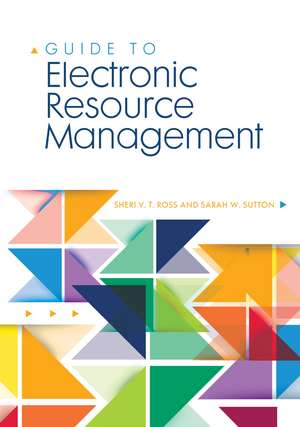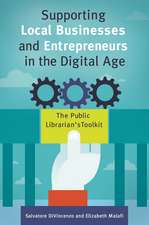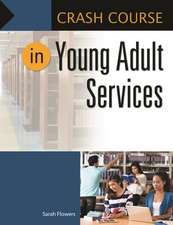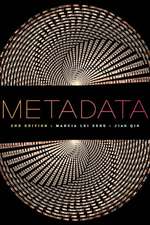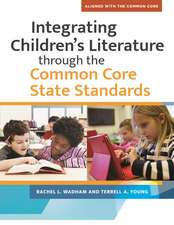Guide to Electronic Resource Management
Autor Sheri V. T. Ross, Sarah W. Suttonen Limba Engleză Paperback – 21 feb 2016 – vârsta până la 17 ani
Preț: 332.79 lei
Preț vechi: 385.65 lei
-14% Nou
Puncte Express: 499
Preț estimativ în valută:
63.68€ • 66.49$ • 52.70£
63.68€ • 66.49$ • 52.70£
Carte tipărită la comandă
Livrare economică 04-18 aprilie
Preluare comenzi: 021 569.72.76
Specificații
ISBN-13: 9781440839580
ISBN-10: 1440839581
Pagini: 174
Dimensiuni: 178 x 254 x 10 mm
Greutate: 0.39 kg
Editura: Bloomsbury Publishing
Colecția Libraries Unlimited
Locul publicării:New York, United States
ISBN-10: 1440839581
Pagini: 174
Dimensiuni: 178 x 254 x 10 mm
Greutate: 0.39 kg
Editura: Bloomsbury Publishing
Colecția Libraries Unlimited
Locul publicării:New York, United States
Caracteristici
Features information on standards development, new product assessment, and idea exchange for both novice and experienced librarians
Notă biografică
Sheri V. T. Ross is associate professor for the master of library and information science program at St. Catherine University.Sarah W. Sutton, PhD, is an assistant professor in the School of Library and Information Management at Emporia State University.
Cuprins
Preface1 Emergence and Entrenchment of Electronic Resources in LibrariesEmergence of Electronic Resources in LibrariesAdvantages of Electronic Resources to Librarians and Library CustomersDisadvantages of Electronic Resources to Librarians and Library CustomersWorking with Electronic Resources: Who Is Responsible?Core Competencies for the Electronic Resources LibrarianLife Cycle of Electronic ResourcesTechnologyResearch and AssessmentEffective CommunicationSupervising and ManagementTrends and DevelopmentPersonal QualitiesFinal Words on CompetenciesReferences2 The Information EnvironmentDigital Content ProvidersEarly Days of Digital ContentContent PublishersContent VendorsDigital Content Supply ChainDynamics of a Competitive MarketplaceMarket PowerActivitiesReferencesFurther Reading3 Information StandardsInternational StandardsNational StandardsProfessional StandardsActivitiesReferencesFurther Reading4 Identifying and Selecting Electronic ResourcesDevelopment of Digital FormatsIdentifying ResourcesSelecting Electronic ResourcesTrialing the ResourceActivityReferencesFurther Reading5 Acquiring and Licensing Electronic ResourcesContract BasicsLicensing Best PracticesDigital Content License ProvisionsStandard ClausesAuthorized UsersAuthorized UseLicensee and Licensor ObligationsFinalizing the AgreementActivitiesReferencesFurther Reading6 Providing Access to Electronic ResourcesAdministrative Module ManagementEntry URLs and Access to the Administrative ModuleRegistration and Local CollectionsCustomizing Services and PreferencesThe Search ExperienceThe Results DisplayBrandingOther Customization OptionsProxy Servers and AuthenticationPutting It All TogetherThe Customer's ViewThe Internal OperationsSingle Sign-On ServicesTechnological ExpertiseActivitiesReferencesFurther Reading7 Managing Access and DiscoverySystemsStandardsDiscoveryActivityReferencesFurther Reading8 Assessing Electronic ResourcesAssessment PlanningUse StatisticsAssessment ReportingDeselecting Electronic ResourcesActivityReferences9 Preserving Electronic ResourcesPreservation IssuesWhose Responsibility Is It?SustainabilityWhat to PreservePerpetual AccessThe Role of Public PolicyPreservation InitiativesRepositoriesGoogle BooksHathiTrustLOCKSSPorticoOther Preservation Initiatives of NoteActivityReferences10 Scholarly CommunicationMajor Players in Scholarly CommunicationDefining ResearchScholars and ResearchersPublishersFunding AgenciesLibrariesMajor Influences on Scholarly CommunicationTechnologyOpen AccessTenure and PromotionPublic PolicyScholarly Communication and the Management of Electronic ResourcesActivityReferences11 Future Directions of Electronic Resource ManagementContentPreservationScholarly CommunicationTechnologyElectronic Resource Librarian CompetenciesReferencesIndex
Recenzii
Essential for library school students and beginning librarians who need to understand the basics of electronic resource management.
Identification, selection, acquisition, providing access, and assessing the resources will be the sections librarians new to electronic resources will need the most. . . . [T]hose new to electronic resources or who wish to delve more into this specific field of librarianship will appreciate the layout and information found in this guide.
Clear section and chapter headings make Guide to Electronic Resource Management the preferred text for library and information science educators looking for class assignment and content delivery. . . . My choice if I were looking for a current ER resources management book as a textbook for ER librarianship in an instructional setting.
Identification, selection, acquisition, providing access, and assessing the resources will be the sections librarians new to electronic resources will need the most. . . . [T]hose new to electronic resources or who wish to delve more into this specific field of librarianship will appreciate the layout and information found in this guide.
Clear section and chapter headings make Guide to Electronic Resource Management the preferred text for library and information science educators looking for class assignment and content delivery. . . . My choice if I were looking for a current ER resources management book as a textbook for ER librarianship in an instructional setting.
